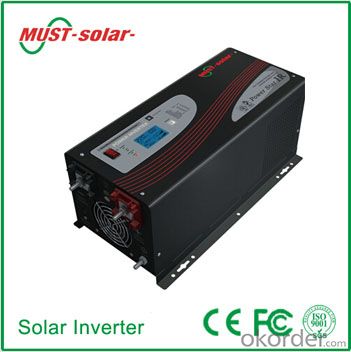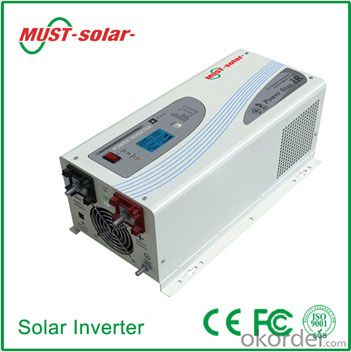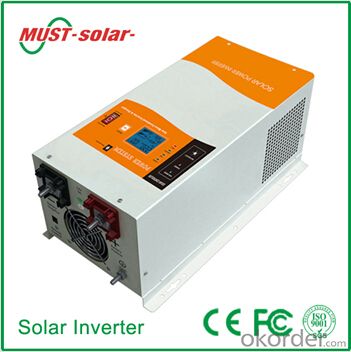Off-Grid Low Frequency PV Inverter EP3200 Series 4KW-6KW
- Loading Port:
- China main port
- Payment Terms:
- TT or LC
- Min Order Qty:
- 50 unit
- Supply Capability:
- 1000 unit/month
OKorder Service Pledge
OKorder Financial Service
You Might Also Like
1. Structure of Off-Grid Low Frequency PV Inverter Description
EP3200 series off-grid low frequency PV inverter adopt very new model copper transformer so the efficiency reach to 90% and lower
consumption (NEW !)
Pure sine wave solar hybrid inverter for solar system and home appliances . EP3200 series off-grid low frequency PV inverter developed on
the base of our very popular EP3000 series . EP3200 has achieved significant improvements on battery charging , AC transfer , bypass
etc .
By adopting DIP(Dual-in-line) switch , EP3200 series off-grid low frequency PV inverter provides more smarter options for users to
customize the performance of the device . Main for home solar system including air conditioner , refrigerator , washing machine , water
pump , fans , tv , lights etc.
2. Main Features of the Off-Grid Low Frequency PV Inverter
• High overload ability of our EP3200 charger is up to 300% rated power
• EP3200 pure sine wave inverter adopts low quiescent current, and power saver mode to reduce power consumption to 3W . It can extract
max. power from various batteries with different protections, and low voltage trip can be selected (10V/10.5V/11V).
• Uses PFC (power factor correction) for charger, which has less power consumption than conventional units.
• It has 10s delay before transfer when AC resumes, and overload protection when our APC pure sine wave inverter equips with generator.
• 10ms typical transfer time between battery and AC, which guarantees power continuity of EP3200 charger. Uses selectable input AC
voltage (185-265V or 155-255V) for different kinds of loads.
• Our EP3200 charger allows start up and through power with depleted batteries. Its powerful charge rate up to 70Amp.
• It can offer 3-step intelligent battery charging, and equipped with 6 preset battery type selector for totally flat batteries.
• LCD status display, battery/AC priority switch, RS232 communication port are available for our EP3200 pure sine wave inverter, it also
has 17 alarms/warnings for easier operation and trouble-shooting, and ability to switch the unit on/off. In addition, select/deselect power
saver mode can be used too.
3. Off-Grid Low Frequency PV Inverter Images




4. Off-Grid Low Frequency PV Inverter Specification
Rated Capacity | 4000W | 5000W | 6000W | |
Efficiency | >90% | |||
Input | ||||
Model | 120v Models | 230v Models | ||
Nominal Voltage | 100V/110V/115V/120VSelectable | 200V/220V/230V/240V Selectable | ||
Output | ||||
Rated Power | 4000W | 5000W | 6000W | |
Output Voltage | 100V/110V/115V/120V Selectable | 200V/220V/230V/240V Selectable | ||
Voltage Waveform | Pure Sine Wave | |||
Crest Factor | 3:01 | |||
Transfer Time | Transfer Time : AC To DC : 10ms (Typical) | |||
Transfer Time : DC To AC : 10ms(Typical ) | ||||
Max Bypass | 30A | |||
Overload Current | ||||
Input | ||||
Nominal Voltage | DC24V/48V | DC48V | DC48V | |
Over Current Protection | By Re-Settable Over Current Protector | |||
Output | ||||
Regulation (Nominal) | ±10% Typical Of Nominal Voltage | |||
Nominal Input Voltage | 230Vac | |||
Input Voltage Range | 185-265Vac | |||
Nominal Output Voltage | According To The Battery Type | |||
Nominal Charge Current | 30Amp-70Amp | |||
Battery Type | Lead-Acid 12Ah ~ 250Ah | |||
Typical Backup Time | No Limit | |||
Charging Method | Smart Pulse Charging With Two Charging Modes: | |||
Quick Charging When Battery Is Not Fully Charged, | ||||
Trickle Charging When Battery Is 90% Fully Charged. | ||||
Average Charging | 65A/35A | 70A/40A | 50A | |
Current | ||||
Battery Voltage options | ||||
Options 7 | Battery low trip to bypass 11v , high trip to battery 14v | |||
Options 8 | Battery low trip to bypass 10.5v , high trip to battery 13.5v | |||
Options 9 | Battery low trip to bypass 10v , high trip to battery 13v | |||
Communications & Management | ||||
Control Panel | LCD/LED Option | |||
Audible Alarm | Alarm On Battery: | |||
Low Battery & Battery Over Voltage | ||||
Alarm On Abnormal Operation: | ||||
Over Load, Short-Circuit, & Over Heat | ||||
Environment And Safe | ||||
Operating | 0℃ To 40℃ (32℉ To 104℉) | |||
Temperature | ||||
Transit/Storage | -15℃ To 60℃ | |||
Temperature | ||||
Audible Noise | 60 Dba Max at 1m | |||
Quality Control System | ISO 9001,FCC,CE | |||
Physical | ||||
Dimensions: (H×D×W) | 755*320*310mm | |||
G.W (Kg) | 37.5 | 47.5 | 47.5 | |
Packing | Export Carton For Each Unit Per Carton | |||
5. FAQ of Off-Grid Low Frequency PV Inverter
Q1. What is the difference between inverter and Off-Grid Low Frequency PV Inverter?
A1. Inverter only has AC inpput, but Off-Grid Low Frequency PV Inverter both connect to AC input and solar panel, it saves more power.
Q2. What is the difference between MPPT&PWM?
A2. MPPT has higher efficiency, it can track the max power point and won't waste energy.
Q3. What is the waranty of product?
A3. 12 months.
- Q:How does the power factor correction affect the performance of a solar inverter?
- Power factor correction (PFC) plays a significant role in improving the performance of a solar inverter. By correcting the power factor, the inverter can efficiently convert DC power from the solar panels into AC power for use in homes or the grid. A high power factor ensures that the inverter operates at its maximum capacity, reducing power losses and improving overall energy efficiency. Additionally, a well-corrected power factor minimizes harmonic distortion, resulting in a stable and reliable operation of the solar inverter.
- Q:How does the input voltage rating affect the performance of a solar inverter?
- The input voltage rating of a solar inverter directly affects its performance as it determines the maximum voltage that the inverter can handle from the solar panels. If the input voltage exceeds the rating, it can lead to overloading or damage to the inverter. On the other hand, if the input voltage falls below the rating, it can result in reduced efficiency and power output. Therefore, selecting an inverter with an appropriate input voltage rating is crucial to ensure optimal performance and longevity of the solar system.
- Q:How do you troubleshoot common issues with a solar inverter?
- To troubleshoot common issues with a solar inverter, first, check the display panel for any error messages or indicators. If there are none, ensure that all connections, including DC and AC cables, are securely tightened. Next, verify if there is sufficient sunlight reaching the solar panels. If the issue persists, inspect the fuse or circuit breaker and replace if necessary. Additionally, investigate the inverter's performance logs to identify any irregularities. If these steps do not resolve the problem, it is recommended to consult a professional solar technician for further assistance.
- Q:What is the importance of overcurrent protection in a solar inverter?
- The importance of overcurrent protection in a solar inverter is to ensure the safety and longevity of the system. Overcurrent protection helps prevent damage to the inverter and other components by interrupting the flow of excessive current. It safeguards against potential hazards such as overheating, electrical fires, and equipment failures. Additionally, overcurrent protection helps maintain the efficiency and performance of the solar inverter, ensuring optimal power generation and system reliability.
- Q:What is the role of a power quality analyzer in a solar inverter?
- The role of a power quality analyzer in a solar inverter is to monitor and analyze the quality of the electrical power being generated by the solar panels. It measures various parameters such as voltage, current, frequency, harmonics, and power factor to ensure that the power being generated is within acceptable limits and meets the required standards. By detecting any deviations or abnormalities in the power quality, the analyzer helps in identifying and rectifying issues that could affect the performance and efficiency of the solar inverter and the overall solar power system.
- Q:What is the role of power ramp rate control in a solar inverter?
- The role of power ramp rate control in a solar inverter is to regulate the rate at which the power output of the solar panels increases or decreases. This control feature helps to ensure a smooth and gradual transition in power generation, thereby preventing sudden fluctuations and potential grid instability. By managing the rate at which power is introduced to the grid, power ramp rate control helps to maintain the stability and reliability of the overall electrical system.
- Q:Can a solar inverter be installed indoors?
- Yes, a solar inverter can be installed indoors.
- Q:How does a solar inverter handle islanding detection and prevention?
- A solar inverter handles islanding detection and prevention by continuously monitoring the electrical grid. If the solar inverter detects a disturbance or a loss of grid power, it immediately stops injecting power into the grid. This action helps prevent the formation of an island, where a portion of the grid remains energized by the solar inverter while the main grid is down. By actively monitoring and ceasing power injection during grid abnormalities, a solar inverter ensures the safety of utility workers and prevents potential equipment damage.
- Q:Are there any fire safety concerns associated with solar inverters?
- Yes, there are some fire safety concerns associated with solar inverters. While solar inverters themselves are not typically a fire hazard, there are a few potential risks to consider. Firstly, improper installation of the solar inverter can lead to electrical issues that may cause a fire. It is important to hire a qualified and certified professional to install the inverter, ensuring that all electrical connections are secure and up to code. Secondly, if the solar inverter is located in an area that is prone to high temperatures or excessive heat, there is a risk of overheating. Inverters generate heat as they convert the direct current (DC) from solar panels into alternating current (AC) for use in homes or businesses. If the inverter is not properly ventilated or if it is exposed to extreme heat, it can overheat and potentially start a fire. Additionally, if there is a fault in the inverter or if it is damaged, it can increase the risk of fire. Regular maintenance and inspection of the solar inverter can help identify any potential issues and ensure its safe operation. To mitigate these fire safety concerns, it is crucial to follow proper installation guidelines, regularly inspect and maintain the inverter, and ensure it is located in a well-ventilated area away from excessive heat sources. It is also advisable to have a fire extinguisher nearby and to have a fire safety plan in place in case of emergencies.
- Q:Can a solar inverter be used with a solar-powered electric vehicle charging station?
- Yes, a solar inverter can be used with a solar-powered electric vehicle charging station. The solar inverter is responsible for converting the direct current (DC) electricity generated by the solar panels into alternating current (AC) electricity that can be used to charge electric vehicles. This allows the solar-powered charging station to efficiently utilize the solar energy and provide clean and sustainable charging for electric vehicles.
1. Manufacturer Overview |
|
|---|---|
| Location | |
| Year Established | |
| Annual Output Value | |
| Main Markets | |
| Company Certifications | |
2. Manufacturer Certificates |
|
|---|---|
| a) Certification Name | |
| Range | |
| Reference | |
| Validity Period | |
3. Manufacturer Capability |
|
|---|---|
| a)Trade Capacity | |
| Nearest Port | |
| Export Percentage | |
| No.of Employees in Trade Department | |
| Language Spoken: | |
| b)Factory Information | |
| Factory Size: | |
| No. of Production Lines | |
| Contract Manufacturing | |
| Product Price Range | |
Send your message to us
Off-Grid Low Frequency PV Inverter EP3200 Series 4KW-6KW
- Loading Port:
- China main port
- Payment Terms:
- TT or LC
- Min Order Qty:
- 50 unit
- Supply Capability:
- 1000 unit/month
OKorder Service Pledge
OKorder Financial Service
Similar products
New products
Hot products
Hot Searches
Related keywords

































